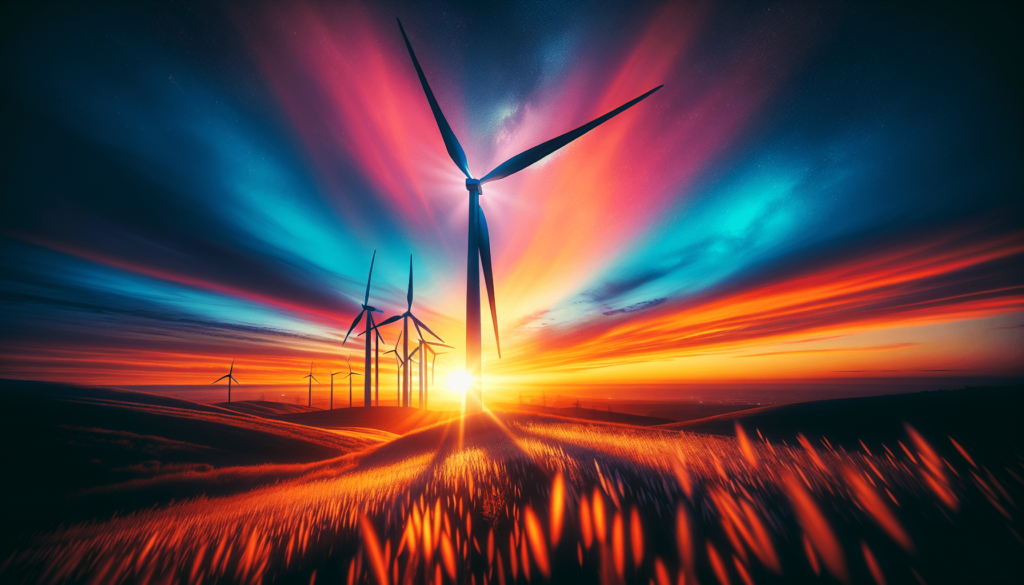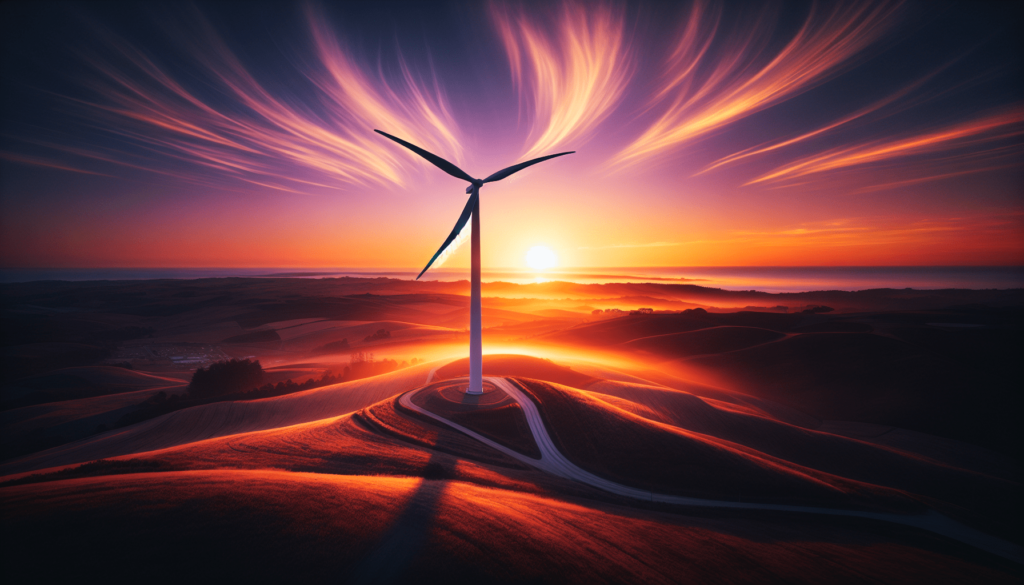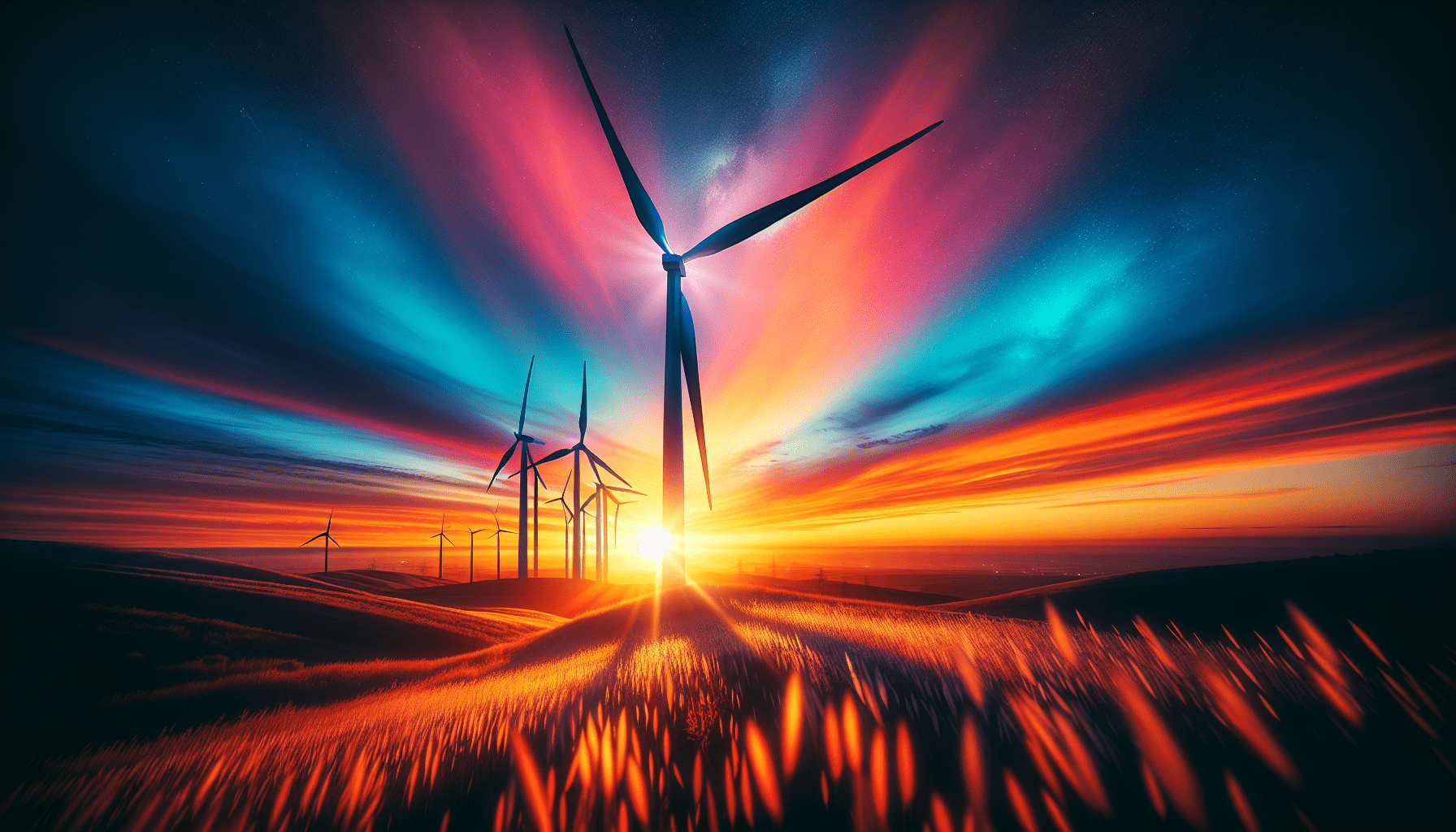Imagine a world where homes are powered by solar energy, cars run on clean hydrogen fuel, and waste is efficiently converted into renewable resources. This is not merely a figment of your imagination; it is the future of green technology. With advancements in renewable energy, sustainable materials, and innovative solutions, the world is on the brink of a revolution that will reshape the way we live and protect our planet. In this article, we will explore the exciting developments in green technology and how they are set to transform our future for the better. Get ready to be inspired by the endless possibilities that lie ahead!

Renewable Energy
Solar Power
Solar power is a rapidly growing field in the renewable energy sector. It harnesses the energy of the sun to generate electricity. Solar panels, made up of photovoltaic (PV) cells, convert sunlight into usable energy. The beauty of solar power lies in its scalability – it can be installed on a small scale for individual homes or on a large scale for utility-scale applications. With advancements in technology, solar panels now have higher efficiency rates and are more affordable than ever before. Solar power is a clean and abundant source of energy that can help reduce reliance on fossil fuels and combat climate change.
Wind Power
Wind power is another prominent form of renewable energy. It harnesses the power of the wind to generate electricity through wind turbines. As the wind blows, it causes the turbine blades to spin, converting the kinetic energy into electrical energy. Wind power is a highly sustainable and widely available source of energy, particularly in areas with consistent wind patterns. It is a clean source of energy that produces no greenhouse gas emissions and helps to diversify the energy mix. Over the years, wind turbine technology has advanced, resulting in larger and more efficient turbines capable of producing more electricity.
Hydroelectric Power
Hydroelectric power is a long-established form of renewable energy that harnesses the energy of flowing or falling water to generate electricity. It involves the construction of dams or barrages to capture the potential energy of water, which is then converted into electrical energy using turbines. Hydroelectric power plants are versatile and can be built on a small scale in rivers or on a large scale in major river systems. They provide a consistent and reliable source of electricity, with the added benefit of being able to store water for periods of high demand. Hydroelectric power is a clean energy option that has minimal environmental impact.
Energy Storage
Battery Technology
Battery technology plays a crucial role in the development of renewable energy. Energy storage systems, such as lithium-ion batteries, allow for the proper utilization and management of intermittent energy sources like solar and wind power. Batteries store excess energy generated during peak production periods and release it during times of high demand. This helps to stabilize the electrical grid and ensure a steady supply of electricity. Advancements in battery technology have led to increased energy density, longer lifespans, and lower costs, making energy storage more accessible and efficient.
Fuel Cells
Fuel cells are another form of energy storage technology that convert chemical energy directly into electrical energy. They use hydrogen as a fuel source, combining it with oxygen to produce electricity, heat, and water as byproducts. Fuel cells can be used for various applications, from powering individual devices to providing electricity for buildings and vehicles. They are highly energy-efficient and produce zero emissions, making them a sustainable alternative to conventional fossil fuel combustion. With ongoing research and development, fuel cells have the potential to revolutionize energy storage and contribute to a greener future.
Flywheels
Flywheel energy storage systems store energy by rotating a large wheel or flywheel at high speeds and then converting the kinetic energy back into electrical energy when needed. They offer quick response times and high power output capabilities, making them suitable for applications that require short bursts of energy. Flywheels can be used in conjunction with renewable energy sources to even out fluctuations in power supply and demand. The technology behind flywheels continues to advance, with improvements in material strength and efficiency, making them an attractive option for energy storage in the future.
Thermal Energy Storage
Thermal energy storage is a technology that captures and stores excess heat or cold for later use. It is particularly valuable for buildings that require heating or cooling throughout the day. Thermal energy storage systems can utilize various methods, including storing heat in underground reservoirs or using phase change materials to absorb and release energy. By storing excess thermal energy during times of low demand and releasing it when demand is high, these systems help to optimize energy usage and reduce the strain on the electrical grid. Thermal energy storage is a promising technology that can enhance the efficiency of renewable energy systems and contribute to a more sustainable future.
Smart Grids
Digital Monitoring & Control
Digital monitoring and control systems are key components of smart grids. These systems collect real-time data on energy consumption and production, allowing for more efficient management of the electrical grid. Through the use of sensors, smart meters, and advanced analytics, utility companies can monitor energy flows, detect faults or inefficiencies, and optimize the distribution of electricity. Digital monitoring and control systems enable better demand forecasting, load balancing, and grid stability, paving the way for a more reliable and resilient energy infrastructure.
Demand Response Systems
Demand response systems empower consumers to actively participate in managing their energy consumption. These systems provide incentives for customers to adjust their electricity use during periods of high demand or when renewable energy generation is limited. By shifting or reducing electricity usage during peak times, consumers can contribute to grid stability and reliability. Demand response systems allow for better integration of renewable energy sources by effectively managing fluctuations in supply and demand. Overall, these systems promote energy conservation, reduce costs, and maximize the utilization of renewable energy resources.
Green Building
Sustainable Materials
Green building focuses on constructing structures that have minimal impact on the environment and maximize energy efficiency. The use of sustainable materials is a fundamental aspect of green building practices. Sustainable materials are responsibly sourced, have lower embodied carbon emissions, and are recyclable or biodegradable. Examples include bamboo flooring, recycled steel, and low VOC (volatile organic compound) paints. Incorporating sustainable materials into building projects helps to reduce resource consumption, minimize waste generation, and create healthier indoor environments.
Energy-Efficient Design
Energy-efficient design is a core principle of green building. It involves implementing strategies and technologies that reduce energy consumption in buildings, such as efficient insulation, high-performance windows, and LED lighting. Energy modeling and simulation tools are used during the design phase to optimize building performance and ensure optimal energy efficiency. Energy-efficient design practices help to lower operational costs, decrease greenhouse gas emissions, and create comfortable living and working environments.
Green Roofs
Green roofs, also known as living roofs or vegetated roofs, are an innovative feature of green building. They involve the installation of a layer of vegetation on the roof surface, providing numerous benefits. Green roofs help to reduce the urban heat island effect, improve air quality, and enhance stormwater management by absorbing and filtering rainwater. They also provide additional insulation, reducing the need for heating and cooling. Green roofs contribute to biodiversity and create aesthetically pleasing spaces, making them a valuable addition to sustainable building practices.

Transportation
Electric Vehicles
Electric vehicles (EVs) are rapidly gaining popularity as a green transportation solution. They run on electricity stored in batteries and produce zero tailpipe emissions, contributing to cleaner air and reduced greenhouse gas emissions. With advancements in battery technology, EVs now offer longer range capabilities and faster charging times. The expansion of charging infrastructure is making electric vehicles more accessible and convenient for consumers. The adoption of electric vehicles can significantly reduce our dependence on fossil fuels and mitigate the environmental impacts of transportation.
Hybrid Vehicles
Hybrid vehicles combine an internal combustion engine with an electric motor and battery. They offer increased fuel efficiency and reduced emissions compared to conventional gasoline-powered vehicles. Hybrid vehicles use regenerative braking to recover energy that would otherwise be lost during braking or deceleration, storing it in the battery for later use. The combination of the internal combustion engine and electric motor provides flexibility and range, making hybrid vehicles a transitional technology towards fully electric transportation.
Smart Mobility Solutions
Smart mobility solutions encompass a range of technologies and services aimed at improving the efficiency and sustainability of transportation. These include car-sharing and bike-sharing programs, ride-hailing services, and intelligent transportation systems. By providing alternatives to private car ownership and optimizing traffic flow, smart mobility solutions reduce congestion, lower emissions, and enhance the overall transportation experience. The integration of green technologies, such as electric vehicles and renewable energy charging infrastructure, further enhances the sustainability of smart mobility solutions.
Waste Management
Recycling Technologies
Recycling technologies play a crucial role in waste management and the circular economy. These technologies enable the recovery of valuable resources from waste materials, reducing the need for virgin materials and minimizing environmental impact. Advances in recycling technologies have improved the efficiency and effectiveness of recycling processes, allowing for the recycling of a wider range of materials. From plastic and paper to electronic waste, recycling technologies help to conserve resources, reduce landfill waste, and promote a more sustainable approach to waste management.
Waste-to-Energy Conversion
Waste-to-energy conversion technologies offer a sustainable solution for managing organic waste materials. These technologies convert organic waste into energy, such as electricity or heat, through various processes like anaerobic digestion and incineration. By harnessing the energy potential of waste, these systems not only reduce the volume of waste sent to landfills but also generate renewable energy. Waste-to-energy conversion can contribute to a circular economy by closing the loop on resource utilization and reducing reliance on fossil fuels.
Biodegradable Packaging
Biodegradable packaging is an important innovation in waste management, particularly in the context of single-use plastics. Biodegradable materials break down naturally over time, reducing their environmental impact. These materials can be used in various forms of packaging, from food containers to shopping bags. Biodegradable packaging helps to limit waste generation and reduce pollution, as it breaks down into non-toxic components without leaving behind harmful microplastics. Incorporating biodegradable packaging into our daily lives is a step towards a more sustainable and environmentally friendly future.
Water Conservation
Smart Irrigation Systems
Smart irrigation systems utilize technology to optimize water usage in landscaping and agriculture. These systems incorporate sensors, weather data, and soil moisture monitoring to determine the irrigation needs of plants. By using real-time data and advanced algorithms, smart irrigation systems deliver the right amount of water at the right time, minimizing waste and promoting water conservation. These systems also offer remote control and automation features, allowing users to manage irrigation schedules efficiently.
Water Recycling
Water recycling, also known as water reclamation or reuse, involves the treatment and reuse of wastewater for various purposes. This practice reduces the strain on freshwater sources and helps to conserve water. Through advanced treatment processes, wastewater can be purified to a quality suitable for industrial use, agricultural irrigation, and even potable water supply when combined with additional treatment steps. Water recycling plays a crucial role in water resource management and helps to create a more sustainable water supply.
Desalination
Desalination is the process of removing salt and other impurities from seawater or brackish water to produce freshwater. As freshwater resources become increasingly scarce, desalination offers a viable solution for meeting the growing demand for clean water. Advances in desalination technologies have made the process more energy-efficient and cost-effective. Desalination plants can be powered by renewable energy sources to minimize environmental impacts. Desalination plays a vital role in water conservation, particularly in regions with limited freshwater resources.
Circular Economy
Product Lifecycle Management
Product lifecycle management involves the systematic management of a product throughout its entire lifecycle, from design and manufacturing to disposal or recycling. By considering environmental factors at each stage, product lifecycle management aims to optimize resource utilization, reduce waste generation, and promote a circular economy. Strategies such as designing for durability, repairability, and recyclability ensure that products have a longer lifespan and are less likely to end up in landfill.
Closed-loop Systems
Closed-loop systems, also known as closed-loop recycling, refer to the practice of recycling materials and products indefinitely without degradation in quality. In a closed-loop system, materials are collected, processed, and transformed back into new products, creating a continuous cycle of resource utilization. By closing the loop on material flows, closed-loop systems help to reduce waste, conserve resources, and minimize the environmental impact of production and consumption.
Sharing Economy Platforms
Sharing economy platforms facilitate the sharing, renting, or lending of goods and services between individuals or businesses. This approach promotes resource sharing and collaborative consumption, minimizing waste and maximizing the utilization of existing resources. Sharing economy platforms enable the efficient use of products, such as cars, tools, and accommodations, reducing the need for excessive production and consumption. By embracing sharing economy principles, we can move towards a more sustainable and circular economic system.
Artificial Intelligence
Optimization of Energy Systems
Artificial intelligence (AI) has the potential to optimize energy systems by analyzing vast amounts of data and providing valuable insights. AI algorithms can optimize energy generation, consumption, and distribution, maximizing efficiency and reducing waste. By continuously learning and adapting, AI systems can monitor and predict energy demand patterns, helping utility companies make informed decisions and balance supply and demand in real-time. AI optimization of energy systems contributes to the integration of renewable energy, grid stability, and more sustainable energy management.
Smart Home Automation
Smart home automation utilizes AI and Internet of Things (IoT) technology to make homes more energy-efficient and environmentally friendly. AI-powered systems can automatically adjust lighting, heating, cooling, and other appliances to optimize energy consumption based on occupants’ preferences and patterns. Smart home automation enables remote control and monitoring, allowing users to manage their energy usage efficiently and reduce waste. By leveraging AI capabilities, smart home automation enhances comfort, convenience, and sustainability in residential buildings.
Predictive Maintenance
Predictive maintenance refers to the use of AI and machine learning algorithms to predict equipment failures and optimize maintenance schedules. By analyzing historical data and real-time sensor data, AI systems can identify patterns and anomalies that indicate potential equipment malfunctions. Predictive maintenance allows for proactive repairs and replacements, reducing downtime, extending equipment lifespan, and minimizing unnecessary maintenance interventions. By optimizing maintenance practices, AI contributes to energy efficiency and reduces waste in various sectors, from manufacturing to energy production.
Environmental Monitoring
Air Quality Monitoring
Air quality monitoring systems utilize sensors and data analysis algorithms to measure and assess the quality of air in real-time. These systems monitor pollutant levels, such as particulate matter and harmful gases, and provide valuable insights for environmental management and public health. Air quality monitoring helps to identify pollution sources, assess the effectiveness of pollution control measures, and raise awareness about the impacts of air pollution. By monitoring air quality, we can take proactive measures to improve air quality and protect human health.
Water Quality Monitoring
Water quality monitoring involves the measurement and analysis of various physical, chemical, and biological parameters in water bodies. This monitoring allows us to assess the health of freshwater systems, identify pollution sources, and implement appropriate remediation measures. Water quality monitoring plays a crucial role in safeguarding water resources, preserving aquatic ecosystems, and ensuring safe drinking water. With advanced sensors and data analysis techniques, real-time water quality monitoring can be facilitated, allowing for quick responses to potential threats or pollution incidents.
Noise Pollution Monitoring
Noise pollution monitoring aims to assess and manage noise levels in urban and industrial environments. Excessive noise can have detrimental effects on human health and wellbeing. Noise monitoring systems utilize sensors to measure noise levels and provide insights into noise sources and patterns. By identifying noise hotspots and implementing mitigation measures, noise pollution can be reduced, improving quality of life for residents and workers alike. Noise pollution monitoring contributes to creating more livable and sustainable urban environments.

